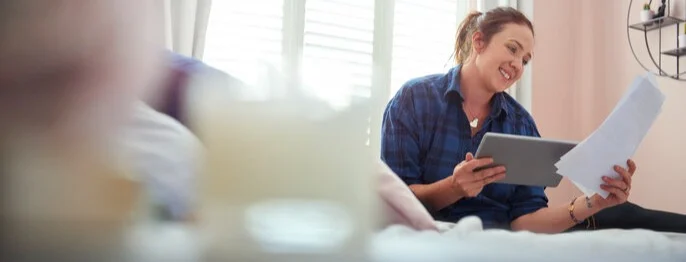
Get rid of your debt faster with debt relief
Choose your debt amount
Or speak to a debt consultant 844-731-0836
- 4 min read
- Running up debt and mutliple bills is a common problem.
- Learn five steps to take to consolidate your Bills.
- Take the shortcut and use Bills.com Debt Navigator to help you consolidate your bills.
- Start your FREE debt assessment
How Do I Consolidate All My Bills?
Who doesn’t have bills? Do you have medical bills, credit card bills, household bills, telephone bills, and do they keep piling up? Are you looking for a simpler and more efficient way to deal with your monthly bills and debt?
Did you know that as of the second quarter 2018 credit card debt is about $829 billion? According to the Q3 2018 NY Federal Quarterly Report on Household Debt and Credit:
"...total household debt rose by $219 billion to reach $13.51 trillion in the third quarter of 2018—an increase of 1.6 percent, up from a rise of 0.6 percent in the second quarter. Balances climbed 1.6 percent on mortgages, 2.2 percent on auto loans, 1.8 percent on credit cards, and 2.6 percent on student loans this past quarter.
You are probably wondering: How does bill consolidation work? Bill consolidation allows you to combine your bills and debt into one affordable payment. Your primary benefits are lower monthly payments or lower overall financial costs. The most common ways to consolidate bills are a personal debt consolidation loan, and a cash-out refinance or home equity mortgage.
However, even if you are in financial hardship, there are ways to consolidate bills The more bills you have, the more tangled your finances can get. And if you're behind on any of your payments, then the web of debt can get even stickier. If you're delinquent on your bill payments, have high-interest rates on multiple loans or credit cards, or are dodging collection agencies, you need to consolidate all bills and start tackling your debt.
How to Consolidate Bills: Five Steps
To consolidate your debt and bills, follow these five steps:
- Take stock of your bills and debt: Get a free copy of your credit report that will allow you to look at all of your recurring obligations, including balances, monthly payments, and interest rates. Also, take the time to write down all of your other bills, including medical bills and other expenses that don’t show up on your credit card. If you have multiple types of debt, then use Bills.com debt consolidation calculator to help you organize them and get tips on how to consolidate them.
- Take stock of your budget: If you are going to consolidate bills, you need to know how much money you make, how much money you spend and how much money you have available to pay each down your debt. To keep tabs on your bills, make sure to create and maintain a budget.
- Check your assets: Write down all of your significant assets including cars, home, retirement funds, savings accounts, and investment accounts. Maybe you can use some of the assets as collateral to take out an affordable and low-interest bill consolidation loan. Or, perhaps you have assets you can use to pay off your bills?
How to Consolidate Your Bills - Use Bills.com Debt Relief Guide
Check out BIlls.com Debt Relief Guide to help you analyze your financial situation and find a debt relief option. The guide includes templates to analyze your budget, net worth, and debt relief goals. In addition, you can learn about various debt relief options.
- Check your credit score: Check your credit score with a lender, your credit card statement, or through an online site that tracks your credit. Your credit score will be a factor in choosing the best bill consolidation tactic. If you have excellent credit, then you can qualify for low-interest bill consolidation loans.
- Choose a bill consolidation tactic: Finding the most appropriate bill consolidation tactic can be complicated. The most common bill consolidation tactics for people with excellent credit are a personal loan, cash-out or home equity mortgage. However, there are bill tactics for people with varying degrees of hardship including, credit counseling, debt management program, debt settlement, and bankruptcy. You need to be able to juggle all of the information and match your goals with bill consolidation options.
Get a Personal Loan to Consolidate Bills:
Bills.com makes it easy to shop for a bill consolidation personal loan. Start by filling in your credit score, zip code, loan purpose, and the amount of loan you need. Check out different offers and click on the appropriate ones.
How to Choose a Bill Consolidation Tactic That Fits Your Needs
The hard part of consolidating bills is finding a tactic that best fits your situation. The good news is that there is a simple answer to: How to I consolidate my debt? Bills.com created an innovative tool, the Debt Navigator.
Bills.com Debt Navigator tool helps you analyze the best bill consolidation alternatives. Answer a few questions about your personal financial situation (debt, income, homeownership, financial goal, level of hardship), authorize a soft pull on your credit, with no impact on your credit score, provide personal contact information, and then click on the button. You will get a picture of your debt on one page as well as up to five different debt consolidation solutions. Pick the solution or solutions that seem best to you and get more information from Bills.com debt providers.
How to Consolidate Your Bills in a Financial Hardship
Are you in a Financial Hardship? If you are struggling to make minimum payments, then debt settlement may be the best bill consolidation option. Get a free consultation with one of Bills.com's pre-screened debt providers.

Get rid of your debt faster with debt relief
Take the first step towards a debt-free life with personalized debt reduction strategies.
Choose your debt amount
Or speak to a debt consultant 844-731-0836
Recommended Reads








I ran up medical bills and credit card debt. I still need medical treatment and really need to find a monthly payment I can afford. Someone told me not to put the debt on my home, but I think that the monthly payment on the personal loan is too high. What should I do?
The major downside of putting unsecured debt on your home is if you default it is easier to take away your home then to get other assets. A cash-out refinance can really help your finances. You do need to have equity in your home, as lenders limit the amount of money you can take out. It really lowers your monthly payments and since it is a long-term loan the interest rate is attractive. Lenders also offer home equity loans, so make sure you shop around. Good luck and wish you the good health.